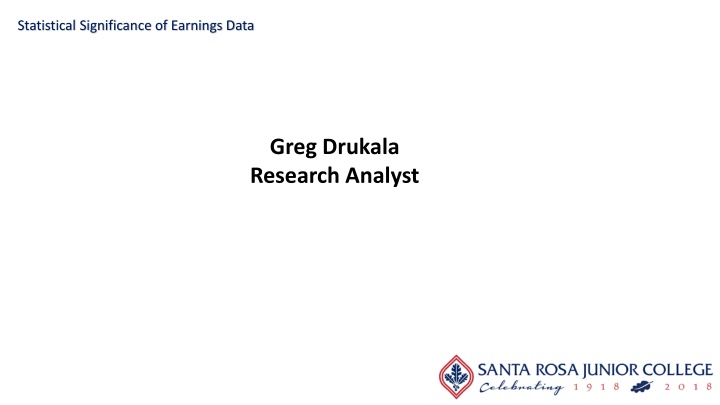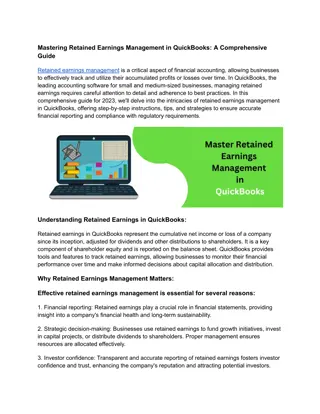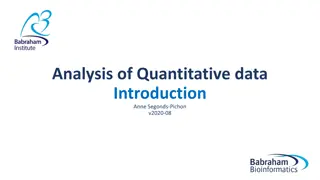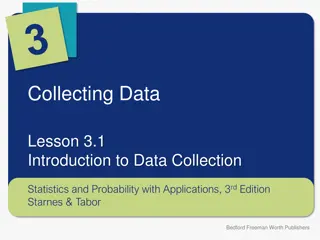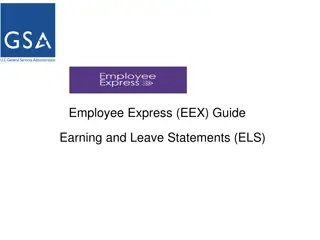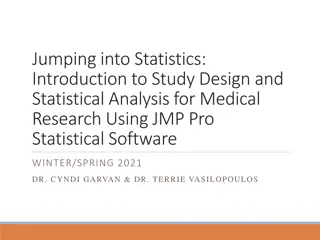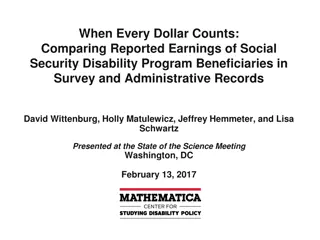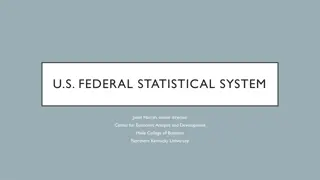Statistical Significance of Earnings Data Analysis
The statistical significance of earnings data analysis, including hypothesis testing based on outcome variables, comparison group considerations, and hypothesis formulation. Learn about setting up null and research hypotheses, selecting appropriate test statistics, and creating visualizations in Tableau. Utilize formulas from Lisa Sullivan, PhD, for hypothesis testing. Dive into the methodology and steps involved in analyzing earnings data for valuable insights
Download Presentation

Please find below an Image/Link to download the presentation.
The content on the website is provided AS IS for your information and personal use only. It may not be sold, licensed, or shared on other websites without obtaining consent from the author.If you encounter any issues during the download, it is possible that the publisher has removed the file from their server.
You are allowed to download the files provided on this website for personal or commercial use, subject to the condition that they are used lawfully. All files are the property of their respective owners.
The content on the website is provided AS IS for your information and personal use only. It may not be sold, licensed, or shared on other websites without obtaining consent from the author.
E N D
Presentation Transcript
Statistical Significance of Earnings Data Greg Drukala Research Analyst
Statistical Significance of Earnings Data Hypothesis Testing Depends on Type of outcome variable being analyzed (continuous, dichotomous, etc.) The number of comparison groups in the investigation Whether the comparison groups are independent or matched
Statistical Significance of Earnings Data Upper, Lower and Two Tailed H0 null hypothesis (no change, no difference) H1 research hypothesis: - If only increase is hypothesized: upper-tailed test - If only decrease is hypothesized: lower-tailed test - If any difference is hypothesized: two-tailed test
Statistical Significance of Earnings Data Steps we will follow Step 1 Set up null hypothesis (H0) and research hypothesis (H1) Step 2 Select the appropriate test statistics (formulae we will use in Tableau) Step 3 Set up decision rule (i.e. under which circumstance we will reject the null hypothesis)
Statistical Significance of Earnings Data Steps we will follow Step 4 Create Calculated Fields in Tableau Step 5 Create the visualizations in Tableau The following formulas are from Lisa Sullivan, PhD, article Hypothesis Testing for Means and Proportions , Boston University School of Public Health (http://sphweb.bumc.bu.edu/otlt/MPH-Modules/BS/BS704_HypothesisTest-Means-Proportions/)
Statistical Significance of Earnings Data Step 1 H0 - no difference in earnings before and after H1 - a difference (increase of decrease) in earnings (two-tailed test)
Statistical Significance of Earnings Data Step 2 Look at the formulae:
Statistical Significance of Earnings Data Step 2 Look at the formulas:
Statistical Significance of Earnings Data Step 3 Two-tailed test, using a Z statistics and 5% level of significance we will reject H0 if Z <= -1.960 or Z >= 1.960.
Statistical Significance of Earnings Data Step 3 Two-tailed test, using a Z statistics and 5% level of significance we will reject H0 if Z <= -1.960 or Z >= 1.960.
Statistical Significance of Earnings Data Step 4 We will need these values (for Current and Former earnings): N sample size MEAN the average value for earnings STDEV standard deviation for earnings Current-N sum(iif(isnull([Current Wages]) = false and [Current Wages] != 0, 1, 0, 0)) Current-MEAN avg([Current Wages]) Current-STDEV stdevp([Current Wages])
Statistical Significance of Earnings Data Step 4 PercentChange if [Former-MEAN] = 0 then 0 else ([Current-MEAN] - [Former-MEAN])/[Former-MEAN] end Bar Color if [PercentChange] > 0 then "blue" else "orange" end
Statistical Significance of Earnings Data Step 4 S subP sqrt((([Former-N] - 1) * square([Former-STDEV]) + ([Current-N] - 1) * square([Current-STDEV])) / ([Current-N] + [Former-N] - 2)) Z score if [Current-N]>=10 or [Former-N]>=10 then ([Current-MEAN]-[Former-MEAN]) / ([S subP] * sqrt((1/[Current-N]) + (1/[Former-N]))) ELSE 0 END Z score significance dot (note: use lower case L and set the font to Wingdings ) if abs([Z score]) >= [Confidence Level] then "l" else "" end
Statistical Significance of Earnings Data What About Small Samples? If n < 30 we should use t-test instead of Z-test. Fortunately, the formulas are the same. The only difference is the Step 3 (decision rule). For t-test, the decision rule is based on the number of degrees of freedom in the sample (df = N 1). The t-distribution table would need to be implemented in Tableau. It looks something like this:
Statistical Significance of Earnings Data Critical Values of t-Distribution The table shows the critical t-values for a given alpha level (one-tailed) and degrees of freedom The degrees of freedom are the rows (denoted by v) Note: The probability levels represent the whole of alpha (you must divide alpha by 2 if you want the t-value for a two-tailed test) v 0.1000 0.0500 0.0250 0.0100 0.0050 0.0010 0.0005 3.078 1.886 1.638 1.533 1.476 1.440 1.415 1.397 1.383 1.372 1.363 1.356 1.350 1.345 1.341 1.337 1.333 1.330 1.328 1.325 6.314 2.920 2.353 2.132 2.015 1.943 1.895 1.860 1.833 1.812 1.796 1.782 1.771 1.761 1.753 1.746 1.740 1.734 1.729 1.725 12.706 4.303 3.182 2.776 2.571 2.447 2.365 2.306 2.262 2.228 2.201 2.179 2.160 2.145 2.131 2.120 2.110 2.101 2.093 2.086 31.821 6.965 4.541 3.747 3.365 3.143 2.998 2.896 2.821 2.764 2.718 2.681 2.650 2.624 2.602 2.583 2.567 2.552 2.539 2.528 63.657 9.925 5.841 4.604 4.032 3.707 3.499 3.355 3.250 3.169 3.106 3.055 3.012 2.977 2.947 2.921 2.898 2.878 2.861 2.845 318.309 22.327 10.215 7.173 5.893 5.208 4.785 4.501 4.297 4.144 4.025 3.930 3.852 3.787 3.733 3.686 3.646 3.610 3.579 3.552 636.619 31.599 12.924 8.610 6.869 5.959 5.408 5.041 4.781 4.587 4.437 4.318 4.221 4.140 4.073 4.015 3.965 3.922 3.883 3.850 1 2 3 4 5 6 7 8 9 10 11 12 13 14 15 16 17 18 19 20
Statistical Significance of Earnings Data CurrentWagesBar (note: use a number of alt-2-1-9 symbols 200 of them for the highest wages of $200) left(" " , round([Current-MEAN])) FormerWagesBar left(" " , round([Former-MEAN]))
Statistical Significance of Earnings Data Step 5 Columns: PercentageChange Rows: Std10, Z Score significance dot Color: Bar Color Tooltip: Former Wages Bar, Former-Mean, Current Wages Bar, Current-MEAN
Statistical Significance of Earnings Data if abs([Z score]) >= [Confidence Level] then "the difference is statistically significant" else "" end
Statistical Significance of Earnings Data Things to Do - Implement t-test for samples <= 30 - Apply significance tests to other survey results - Continuous outcome, two matched samples for salary results - Convince others not to trust results that are not statistically significant
Statistical Significance of Earnings Data Useful Links Visualize Survey Data: https://www.tableau.com/learn/whitepapers/visualizing-survey-data Statistical Significance in Tableau: https://www.datarevelations.com/showing-now-versus-then.html Bar-charts in Tooltip: https://public.tableau.com/s/blog/2010/09/using-bar-charts-tooltips Hypothesis Testing for Means and Proportions: http://sphweb.bumc.bu.edu/otlt/MPH- Modules/BS/BS704_HypothesisTest-Means-Proportions Color Vision Impairments Simulator: https://colororacle.org/
